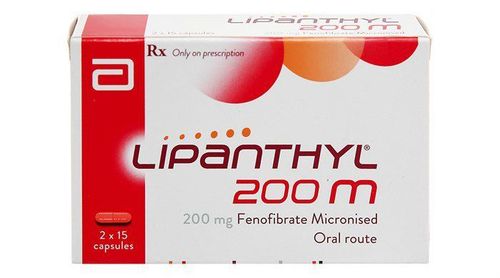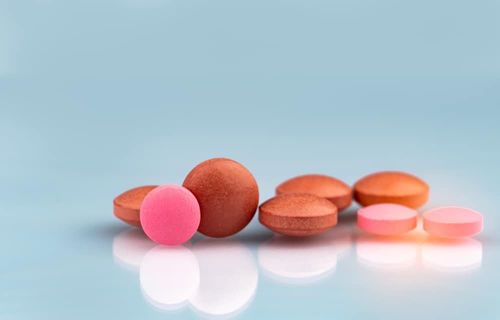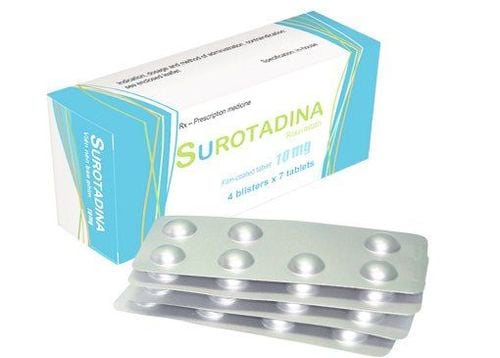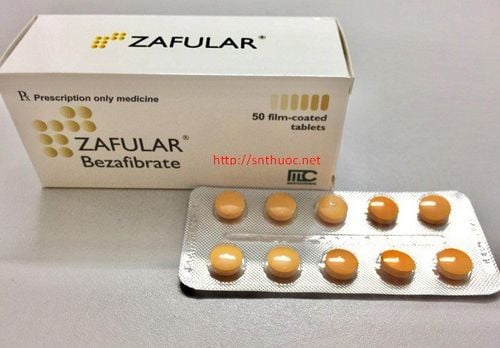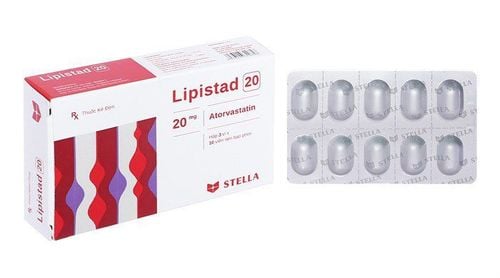This is an automatically translated article.
Katovastin 20mg is a film-coated tablet manufactured in Turkey with the use of cardiovascular disease. Before using Katovastin 20mg, patients should consult their doctor for advice and instructions. The following is some information to help you understand what disease Katovastin 20mg treats?
1. What is Katovastin 20mg?
Katovastin 20mg is a prescription drug, belongs to the group of cardiovascular drugs. The drug was developed by the pharmaceutical company Deva Holding A.S. – Turkish production, imported by Phano Pharmaceutical Joint Stock Company (Vietnam). Registration number VN-17855-14, manufacturer's standard.
Katovastin medicine has the main ingredients:
Katovastin; Lactose monohydrate (pharmatose 200M); Calcium carbonate; Croscarmelose sodium (acdi-sol); Hydroxypropyl cellulose-L; Polysorbat 80 (tween 80); Microcrystalline cellulose (PH 102); Magnesium stearate; Opadry YS-1-7040 white; Emulsion simethicone (silbion antimousse 70460) Katovastin 20mg is prepared as film-coated tablets. The medicine box is white, the name of the medicine is blue, the bottom corner of the box is red. Packed in a box of 3 blisters x 10 tablets, instructions for use.
2. Uses of Katovastin 20mg
Katovastin belongs to the group of drugs known as HMG - CoA Reductase inhibitors. As an anti-hyperlipidemic drug, Atorvastatin competitively, selectively inhibits the enzyme HMG - CoA reductase. This is a catalytic yeast that plays an important role in the conversion of HMG-CoA to mevalonate.Atorvastatin has the ability to reduce concentrations of Total Cholesterol, LDL-Cholesterol (LDL-C) and apolipoprotein B in subjects with homozygous, heterozygous, familial, and disordered hypercholesterolemia. combined dyslipidemia.
Atorvastatin has the ability to reduce the production and number of LDL particles. Atorvastatin strongly and stably increases the activity of LDL receptors. At the same time, they also have the ability to change in favor of circulating LDL particles. Atorvastatin is effective in lowering LDL-C in patients with homozygous familial hypercholesterolaemia, which is often unresponsive to other lipid-lowering therapies. In addition, the metabolites of Atorvastatin help to reduce total cholesterol, LDL - cholesterol, apoliporotein B, increase HDL - C and apolipoprotein.
In general, the main use of Katovastin 20mg is to reduce total cholesterol.
3. Indications to use Katovastin 20mg
What disease does Katovastin treat? This is a drug used for supportive treatment of nutritional solutions aimed at:
Reducing morbidity and mortality in subjects with cardiovascular disease (myocardial infarction with or without life-threatening danger, need for coronary revascularization) in patients with hypercholesterolemia and no clinical manifestations of coronary artery disease. Reduce secondary events (myocardial infarction or non-life threatening stroke, non-life threatening stroke, transient ischemic attack, need for coronary revascularization, and cardiovascular death) in subjects with hypercholesterolemia with clinical manifestations of coronary artery disease. Increased HDL in subjects with primary hypercholesterolemia; Subjects with mixed dyslipidemia (types IIa and IIb); Helps reduce blood triglycerides type IV; In addition, the drug is also used in the treatment of other diseases such as:
Primary dyslipidemia beta (type III); Support in combination with other lipid-lowering solutions aimed at reducing total and LDL cholesterol in subjects with homozygous familial hypercholesterolemia.
4. Dosage, how to use Katovastin 20mg
Katovastin medicine has a simple way of taking it, which is to swallow whole tablets with boiled water to cool in the evening before going to bed. Do not bite, crush, chew or take the drug with carbonated drinks, alcohol, milk or juice... Because it can affect the effectiveness of the drug as well as the risk of changing the chemical composition. contained in Katovastin 20mg.
Before taking the drug, you need to have a reasonable diet to reduce cholesterol. Continue to maintain this regimen throughout the course of taking Katovastin.
Dosage of Katovastin drug according to the manufacturer's instructions as follows:
Subjects with mixed hypercholesterolemia and hyperlipidemia: The recommended dose is 10mg/day, used once/day for the first dose. Next use 10 - 80mg / time. This maximum 80mg/day can be taken as a single dose at any time of the day or without meals. Adjust the dose required for each specific subject according to the baseline LDL-C. Monitor user response and adjust dose as needed. The time for dose adjustment is 2 to 4 weeks after the assessment of lipid levels. Subjects with homozygous familial hypercholesterolemia The recommended dose of Katovastin 20mg is 10 to 80mg/day. It can be used as another lipid-lowering adjunct if Katovastin is not as effective as intended. For patients with renal impairment: Renal disease does not usually affect the plasma concentrations of Atorvastatin and the lipid-lowering effect of the drug. Therefore, use as usual. For young children There have been no studies using doses >20 mg in this population. However, children 10 to 17 years of age with heterozygous familial hypercholesterolemia receive the recommended starting dose of 10 mg/day, up to a maximum of 20 mg/day. For the elderly use Katovastin 20mg The dose of Katovastin 20mg for the elderly > 70 years old is 80mg/day. Dosage of Katovastin 20mg in combination Katovastin 20mg can be used in combination with bile acid-binding resins to increase the effect. Dosage for the group of subjects using concurrently with drugs to treat HIV and hepatitis C With tipranavir + ritonavir use the lowest dose, not more than 20mg/day; With Nelfinavir: not more than 40 mg/day; Dosage of Katovastin 20mg is quite complicated, depending on the specific group of subjects that the doctor will prescribe differently. Therefore, when using it, it is necessary to have guidance, monitoring and prescribed by a doctor.
5. Contraindications to the drug Katovastin
Katovastin 20mg should not be used in the following cases:
History of hypersensitivity, allergy to any ingredients, excipients in the drug Katovastin; History of or ongoing liver disease, unexplained persistent elevation of serum transaminase levels; Are suffering from muscle damage due to concurrent use of Atorvastatin with Gemfibrozide, other Fibrate-lowering blood cholesterol drugs, high-dose Niacin, ..; Subjects with muscle damage, rhabdomyolysis, kidney failure, kidney failure,...; Subjects are pregnant and lactating; The above groups of subjects should not use Katovastin 20mg because it can cause many health risks, even life.
6. Some special precautions and warnings when taking Katovastin 20mg
When using Katovastin, you need to be careful, pay attention to some warnings as follows:
It is necessary to do liver enzyme tests before and while using the drug; If liver damage is detected, it is necessary to evaluate the monitoring function, adjust the dose or stop using the drug; Consider when using Katovastin 20mg with other fibrinolytic agents, high dose niacin, colchicine in patients at risk of muscle damage; Concomitant use of Katovastin with drugs to treat HIV, hepatitis C may increase the risk of muscle damage, rhabdomyolysis, kidney failure, kidney failure; Determination of Creatin Kinase in cases of impaired liver and kidney function, hypothyroidism, hereditary myopathy, heavy drinkers. When using Katovastin 20mg, it is necessary to notify the doctor when there are clinical manifestations in the muscles such as pain, muscle stiffness, muscle weakness... avoid side effects.
7. Interactions when taking Katovastin 20mg
Katovastin 20mg when used with some other drugs may cause reduced interactions or side effects, specifically:
Combination treatment with Statins with Cyclosporin, Erythromycin, Gemfibrozil... may cause side effects. ; Rifampin reduces the concentration of Atorvastatin when co-administered; Concomitant use of HIV protease inhibitors, hepatitis C can increase plasma lipid-lowering drug concentrations, causing many side effects; Amiodron; Diltiazem; Other antacids such as: Antipirin, Colestipol, Cimetidine,...; Contraceptive pills; Cytochrome P450 inhibitors; Katovastin drug interactions are quite complicated, it is necessary to inform your doctor of all medicines you are taking to minimize these risks;
8. Katovastin 20mg . side effects
Katovastin can cause many side effects, especially when taken with other drugs, specifically:
Gastrointestinal side effects: diarrhea, constipation, flatulence – dyspepsia, vomiting and nausea... occurs in about 5% of people taking Katovastin 20mg; Headache, insomnia, body weakness,...; Myalgia, arthralgia, myositis, rhabdomyolysis,...; CKD; Shortness of breath, pneumonia, rhinitis, bronchitis...; You may experience one or more side effects when taking Katovastin 20mg at the same time. Be cautious, notify your doctor of any abnormalities when taking medicine for advice and timely handling.
The above information has answered the question of what disease Katovastin medicine treats? As well as usage, dosage, precautions and warnings. Katovastin 20mg is a prescription drug, so patients absolutely should not buy drugs to treat at home because they may experience unwanted side effects.
Please dial HOTLINE for more information or register for an appointment HERE. Download MyVinmec app to make appointments faster and to manage your bookings easily.




